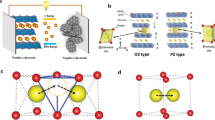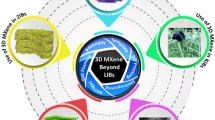Abstract
Bubble-like nitrogen-enriched graphitic carbon was prepared using EDTA-Fe(III) sodium complex (ethylenediaminetetraacetic acid ferric sodium salt) as the precursor. The complex was carbonized at 700 °C for 2 h in argon atmosphere, and then, the product was washed with diluted hydrochloric acid and distilled water to remove iron and iron compounds so as to achieve the hollow carbon nanospheres. The as-prepared bubble-like carbon material exhibits excellent energy storage capability as the anode for lithium-ion batteries. A maximal reversible specific capacity of about 505 mAh g−1 can be achieved at a current density of 100 mA g−1, and 150 mAh g−1 can still be retained at a high current density of 1600 mA g−1, demonstrating superior cycling performance and excellent rate capability mainly due to the unique porous architecture and improved conductivity.








Similar content being viewed by others
References
Ali B, ur-Rehman A, Ghafoor F, Shahzad MI, Shah SK, Abbas SM (2018) J Power Sources 396:467–475
Béguin F, Frackowiak E (2010) Carbons for electrochemical energy storage and conversion systems. CRC Press, Boca Raton
Xie Q, Song R, Zhao P, Zhang Y, Wu S, Xie D (2018) In-plane porous Co3O4nanosheet assembled 3D hierarchical clusters grown on stainless steel mesh as binder-free anodes for high performance lithium ion batteries. J Mater Chem A 6:8388–8395
Flandrois S, Simon B (1999) Carbon materials for lithium-ion rechargeable batteries. Carbon 37:165–180
Xie Q, Zhu Y, Zhao P, Zhang Y, Wu S (2018) One-pot hydrothermal fabrication and enhanced lithium storage capability of SnO2 nanorods intertangled with carbon nanotubes and graphene nanosheets. J Mater Sci 53:9206–9216
Ni J, Huang Y, Gao L (2013) A high-performance hard carbon for Li-ion batteries and supercapacitors application. J Power Sources 223:306–311
Li X, Liu J, Zhang Y, Li Y, Liu H, Meng X, Yang J, Geng D, Wang D, Li R, Sun X (2012) High concentration nitrogen doped carbon nanotube anodes with superior Li+ storage performance for lithium rechargeable battery application. J Power Sources 197:238–245
Dai L, Chang DW, Baek J-B, Lu W (2012) Carbon Nanomaterials for Advanced Energy Conversion and Storage. Small 8:1130–1166
Chen Y, Li X, Park K, Song J, Hong J, Zhou L, Mai Y-W, Huang H, Goodenough JB (2013) Hollow Carbon-Nanotube/Carbon-Nanofiber Hybrid Anodes for Li-Ion Batteries. J Am Chem Soc 135:16280–16283
Ziqi T, Kun N, Guanxiong C, Wencong Z, Zhuchen T, Mujtaba I, Qiubo Z, Huijuan W, Litao S, Xianjun Z, Xiaojun W, Hengxing J, RR S, Yanwu Z (2017) Adv Mater 29:1603414
de las Casas C, Li W (2012) J Power Sources 208:74–85
Zhao Y, Wang LP, Sougrati MT, Feng Z, Leconte Y, Fisher A, Srinivasan M, Xu Z (2017) Adv Energy Mater 7:1601424 n/a
Yan C, Yang J, Xie Q, Lu Z, Liu B, Xie C, Wu S, Zhang Y, Guan Y (2015) Novel nanoarchitectured Zn2SnO4 anchored on porous carbon as high performance anodes for lithium ion batteries. Mater Lett 138:120–123
Cao X, Zheng B, Rui X, Shi W, Yan Q, Zhang H (2014) Metal Oxide-Coated Three-Dimensional Graphene Prepared by the Use of Metal-Organic Frameworks as Precursors. Angew Chem 126:1428–1433
Poizot P, Laruelle S, Grugeon S, Dupont L, Tarascon JM (2000) Nano-sized transition-metal oxides as negative-electrode materials for lithium-ion batteries. Nature 407:496–499
Kovalenko I, Zdyrko B, Magasinski A, Hertzberg B, Milicev Z, Burtovyy R, Luzinov I, Yushin G (2011) A Major Constituent of Brown Algae for Use in High-Capacity Li-Ion Batteries. Science 334:75–79
Koo B, Kim H, Cho Y, Lee KT, Choi N-S, Cho J (2012) A Highly Cross-Linked Polymeric Binder for High-Performance Silicon Negative Electrodes in Lithium Ion Batteries. Angew Chem Int Ed 51:8762–8767
Ata ur R, Ali G, Abbas SM, Iftikhar M, Zahid M, Yaseen S, Saleem S, Haider S, Arshad M, Badshah A (2019) Chem Eng J 375:122021
Campbell B, Ionescu R, Favors Z, Ozkan C, Ozkan M (2015) Bio-Derived, Binderless, Hierarchically Porous Carbon Anodes for Li-ion Batteries. Sci Rep 5:14575
Chen S, Wu J, Zhou R, Zuo L, Li P, Song Y, Wang L (2015) Porous Carbon Spheres Doped with Fe3C as an Anode for High-Rate Lithium-ion Batteries. Electrochim Acta 180:78–85
Javed M, Saqib ANS, Ata ur R, Ali B, Faizan M, Anang DA, Iqbal Z, Abbas SM (2019) Electrochim Acta 297:250–257
Long Q, Wei-Min C, Zhao-Hui W, Qing-Guo S, Xiang L, Li-Xia Y, Xian-Luo H, Wu-Xing Z, Yun-Hui H (2012) Adv Mater 24:2047–2050
Chen L, Wang Z, He C, Zhao N, Shi C, Liu E, Li J (2013) Porous Graphitic Carbon Nanosheets as a High-Rate Anode Material for Lithium-Ion Batteries. ACS Appl Mater Interfaces 5:9537–9545
Hassoun J, Bonaccorso F, Agostini M, Angelucci M, Betti MG, Cingolani R, Gemmi M, Mariani C, Panero S, Pellegrini V, Scrosati B (2014) An Advanced Lithium-Ion Battery Based on a Graphene Anode and a Lithium Iron Phosphate Cathode. Nano Lett 14:4901–4906
Bonaccorso F, Colombo L, Yu G, Stoller M, Tozzini V, Ferrari AC, Ruoff RS, Pellegrini V (2015) Science:347
Kaskhedikar NA, Maier J (2009) Lithium Storage in Carbon Nanostructures. Adv Mater 21:2664–2680
Zhu J, Yang D, Yin Z, Yan Q, Zhang H (2014) Graphene and Graphene-Based Materials for Energy Storage Applications. Small 10:3480–3498
Wu S, Xu R, Lu M, Ge R, Iocozzia J, Han C, Jiang B, Lin Z (2015) Adv Energy Mater 5:1500400 n/a
Xie Q, Zhang Y, Zhu Y, Fu W, Zhang X, Zhao P, Wu S (2017) Graphene enhanced anchoring of nanosized Co3O4 particles on carbon fiber cloth as free-standing anode for lithium-ion batteries with superior cycling stability. Electrochim Acta 247:125–131
Buiel E, Dahn JR (1999) Li-insertion in hard carbon anode materials for Li-ion batteries. Electrochim Acta 45:121–130
Wu Y-P, Wan C-R, Jiang C-Y, Fang S-B, Jiang Y-Y (1999) Mechanism of lithium storage in low temperature carbon. Carbon 37:1901–1908
Ma C, Zhao Y, Li J, Song Y, Shi J, Guo Q, Liu L (2013) The electrochemical performance of pitch coke anodes containing hollow carbon nanostructures and nickel nanoparticles for high-power lithium ion batteries. Electrochim Acta 112:394–402
Wu YP, Rahm E, Holze R (2003) Carbon anode materials for lithium ion batteries. J Power Sources 114:228–236
Nitta N, Wu F, Lee JT, Yushin G (2015) Li-ion battery materials: present and future. Mater Today 18:252–264
Jung C-H, Choi J, Kim W-S, Hong S-H (2018) A nanopore-embedded graphitic carbon shell on silicon anode for high performance lithium ion batteries. J Mater Chem A 6:8013–8020
Zhang J, Wang K, Xu Q, Zhou Y, Cheng F, Guo S (2015) Beyond Yolk–Shell Nanoparticles: Fe3O4@Fe3C Core@Shell Nanoparticles as Yolks and Carbon Nanospindles as Shells for Efficient Lithium Ion Storage. ACS Nano 9:3369–3376
Sadezky A, Muckenhuber H, Grothe H, Niessner R, Pöschl U (2005) Raman microspectroscopy of soot and related carbonaceous materials: Spectral analysis and structural information. Carbon 43:1731–1742
Pawlyta M, Rouzaud J-N, Duber S (2015) Raman microspectroscopy characterization of carbon blacks: Spectral analysis and structural information. Carbon 84:479–490
Sun N, Liu H, Xu B (2015) Facile synthesis of high performance hard carbon anode materials for sodium ion batteries. J Mater Chem A 3:20560–20566
Zhou G, Wang D-W, Shan X, Li N, Li F, Cheng H-M (2012) Hollow carbon cage with nanocapsules of graphitic shell/nickel core as an anode material for high rate lithium ion batteries. J Mater Chem 22:11252–11256
Xie Q, Bao R, Xie C, Zheng A, Wu S, Zhang Y, Zhang R, Zhao P (2016) Core-shell N-doped active carbon fiber@graphene composites for aqueous symmetric supercapacitors with high-energy and high-power density. J Power Sources 317:133–142
Lang J-w, Yan X-b, Liu W-w, Wang R-t, Xue Q-j (2012) J Power Sources 204:220–229
Xing L-B, Xi K, Li Q, Su Z, Lai C, Zhao X, Kumar RV (2016) Nitrogen, sulfur-codoped graphene sponge as electroactive carbon interlayer for high-energy and -power lithium–sulfur batteries. J Power Sources 303:22–28
Li X, Geng D, Zhang Y, Meng X, Li R, Sun X (2011) Superior cycle stability of nitrogen-doped graphene nanosheets as anodes for lithium ion batteries. Electrochem Commun 13:822–825
Qie L, Chen W-M, Wang Z-H, Shao Q-G, Li X, Yuan L-X, Hu X-L, Zhang W-X, Huang Y-H (2012) Nitrogen-Doped Porous Carbon Nanofiber Webs as Anodes for Lithium Ion Batteries with a Superhigh Capacity and Rate Capability. Adv Mater 24:2047–2050
Xie Q, Bao R, Zheng A, Zhang Y, Wu S, Xie C, Zhao P (2016) Sustainable Low-Cost Green Electrodes with High Volumetric Capacitance for Aqueous Symmetric Supercapacitors with High Energy Density. ACS Sustain Chem Eng 4:1422–1430
Zhao X, Xia D, Yue J, Liu S (2014) In-situ generated nano-Fe3C embedded into nitrogen-doped carbon for high performance anode in lithium ion battery. Electrochim Acta 116:292–299
Su L, Zhong Y, Zhou Z (2013) Role of transition metal nanoparticles in the extra lithium storage capacity of transition metal oxides: a case study of hierarchical core–shell Fe3O4@C and Fe@C microspheres. J Mater Chem A 1:15158–15166
Huang Y-G, Lin X-L, Zhang X-H, Pan Q-C, Yan Z-X, Wang H-Q, Chen J-J, Li Q-Y (2015) Fe 3 C@carbon nanocapsules/expanded graphite as anode materials for lithium ion batteries. Electrochim Acta 178:468–475
Wang F, Song R, Song H, Chen X, Zhou J, Ma Z, Li M, Lei Q (2015) Simple synthesis of novel hierarchical porous carbon microspheres and their application to rechargeable lithium-ion batteries. Carbon 81:314–321
Winter M, Besenhard JO, Spahr ME, Novák P (1998) Insertion Electrode Materials for Rechargeable Lithium Batteries. Adv Mater 10:725–763
Zheng T, Xue JS, Dahn JR (1996) Lithium Insertion in Hydrogen-Containing Carbonaceous Materials. Chem Mater 8:389–393
Liu E, Shen H, Xiang X, Huang Z, Tian Y, Wu Y, Wu Z, Xie H (2012) A novel activated nitrogen-containing carbon anode material for lithium secondary batteries. Mater Lett 67:390–393
Han F-D, Yao B, Bai Y-J (2011) Preparation of Carbon Nano-Onions and Their Application as Anode Materials for Rechargeable Lithium-Ion Batteries. J Phys Chem C 115:8923–8927
Zhou X, Ma L, Yang J, Huang B, Zou Y, Tang J, Xie J, Wang S, Chen G (2013) Properties of graphitized boron-doped coal-based coke powders as anode for lithium-ion batteries. J Electroanal Chem 698:39–44
Wu F, Huang R, Mu D, Wu B, Chen Y (2016) Controlled synthesis of graphitic carbon-encapsulated α-Fe2O3 nanocomposite via low-temperature catalytic graphitization of biomass and its lithium storage property. Electrochim Acta 187:508–516
Cao S, Feng X, Song Y, Liu H, Miao M, Fang J, Shi L (2016) In Situ Carbonized Cellulose-Based Hybrid Film as Flexible Paper Anode for Lithium-Ion Batteries. ACS Appl Mater Interfaces 8:1073–1079
Funding
This work was financially supported by the Tianjin Key Projects of New Materials Science and Technology (17ZXCLGX00050).
Author information
Authors and Affiliations
Corresponding author
Additional information
Publisher’s note
Springer Nature remains neutral with regard to jurisdictional claims in published maps and institutional affiliations.
Rights and permissions
About this article
Cite this article
Xie, Q., Zhang, Y., Xie, D. et al. EDTA-Fe(III) sodium complex–derived bubble-like nitrogen-enriched highly graphitic carbon nanospheres as anodes with high specific capacity for lithium-ion batteries. Ionics 26, 85–94 (2020). https://doi.org/10.1007/s11581-019-03234-8
Received:
Revised:
Accepted:
Published:
Issue Date:
DOI: https://doi.org/10.1007/s11581-019-03234-8




